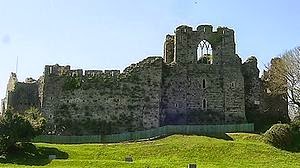Oystermouth Castle stands today in the middle of Mumbles village on the outskirts of Swansea and the edge of the Gower peninsular.
+++castles.jpg) |
| (enjoygower.com) |
When it was originally built it stood on a steep hill overlooking Swansea Bay from the west. With Swansea Castle at the other end of the then shallow bay the main approach to Gower from the east was well guarded. The other side of the Gower peninsular was guarded by Loughor Castle.
The word Oystermouth is a corruption of the Welsh Ystum Llwynarth. Llwynarth means oyster, and the sands of the bay below the castle were famed for their oysters in medieval times.
 |
| (Evening Post) |
The gatehouse of Oystermouth Castle is flanked by two half-towers, which are very unusual. There is no apparent evidence of any intention to build the outer half of the towers and it has long caused speculation. As part of a recent refurbishment, an archaeological dig finally found the foundations of the outer half of the towers, but we still do not know why they were never built.
Inside the castle the keep and adjacent buildings look as though they were built together, but were in fact built in several stages. The last strengthening of the castle was done by William II de Breos (or Braose) after Welsh attacks on the Gower in 1256 & 1288. It was impressive enough that King Edward I stayed there for 2 nights in 1284.
Edward I had just completed the conquest of Wales and made a grand tour of the Principality. I wrote a long chapter on the conquest of Wales for my Alina book, then realised it happened before she was born, and had to take it out! But it is now a short ebook on Amazon for free.
Swansea Castle was the caput or capital of the Lordship of Gower, but it had not been repaired after repeated Welsh attacks, so Oystermouth Castle was used. In fact, the de Braose family preferred to live at Oystermouth for several generations.
 |
| (Wikimedia) |
The last addition to the castle was the chapel block, added in the early 14th century by Alina, the subject of my book Alina, The White Lady of Oystermouth. Following her husband’s part in the barons’ rebellion against Edward II, he was executed and Alina and her son locked in the Tower of London. When Edward III came to the throne the rebels were pardoned and Gower was returned to Alina and her son.
 |
| (Friends of Oystermouth Castle) |
The chapel block is very distinctive, with a square construction and three floors. The lower floors were residential, with the chapel on the top floor. It has beautiful tracery windows, dressed in Sutton stone, and carved pieces brought from Neath Abbey. The recent refurbishment has revealed the remains of medieval paintings on the walls. A glass bridge has been installed so that visitors can now climb the spiral staircase up to the chapel and see it close up.
The refurbishment also provided easier access to the castle and a toilet block. There is now a path which runs round the outside of the field, making a much easier gradient for those who can’t manage the short steep climb to the gate.
The Friends of Oystermouth Castle look after it and run the gift shop inside the chapel tower. The charge is only £2.50 to go in, and there are displays of the castle’s history and a fun cut-out of a knight and his squire for you to put your head through and have your picture taken.
Swansea Council put on various events during the year in the field outside the castle, including concerts, plays and medieval fayres. The castle is open from Easter to the end of September, and is well worth a visit.